Entrepreneur Case Studies
From Hardcore Techie to Unicorn Entrepreneur: Dheeraj Pandey, Founder of Nutanix (Part 2)
Sramana Mitra: When you decided to start Nutanix, what was your understanding of the problem that you were going to go after? Did you have a clear vision of the problem you were going to solve?
Dheeraj Pandey: We had an idea based on our skillsets and passion for distributed systems. If you look at my pattern over those 10 years, I was just building distributed systems. Reliability, availability, serviceability – all these were etched into my fabric. I was like, “Let’s figure out a way to bring this out through an idea.”
>>>From Hardcore Techie to Unicorn Entrepreneur: Dheeraj Pandey, Founder of Nutanix (Part 1)

Inspiring story of a passionate technical founder who has built one of the iconic fast growth Unicorns in the tech industry.
Sramana Mitra: Let’s start at the very beginning of your journey. Where are you from? Where were you born, raised, and in what kind of background?
>>>From MIT PhD Student to Machine Learning Entrepreneur: Verta.ai CEO Manasi Vartak (Part 4)
Sramana Mitra: Besides the guy you brought in from Twitter, who else did you bring in as your key team member? How did you find them?
Manasi Vartak: I recruited through normal channels whether it was through Angel List or emailing people. I also started with a small set of contractors overseas. This was after I had some seed money. That gave us a good start. We still work with them.
Sramana Mitra: What kind of functions?
>>>From MIT PhD Student to Machine Learning Entrepreneur: Verta.ai CEO Manasi Vartak (Part 3)
Sramana Mitra: If you’re an MIT founder, I don’t think gender matters at all.
Manasi Vartak: Based on my experience, I would push back. It’s definitely different. I don’t think it’s terrible. MIT gives you a significant leg up. The other thing that was helping here was that it was an open-source tool that people were using. It wasn’t a question of building, it was more of getting people to pay for it.
Sramana Mitra: You have the product out there as an open-source tool.
>>>From Developer to 2-Time Successful AI Entrepreneur with Exits: Behamics CEO Valon Xhafa (Part 5)
Sramana Mitra: How long did you work in Europe and when did you start coming into the US market?
Valon Xhafa: I worked in Europe for two years and then we started to gain a lot of traction. We suddenly found out that we were getting traction from US.
Sramana Mitra: How were you finding customers?
>>>From MIT PhD Student to Machine Learning Entrepreneur: Verta.ai CEO Manasi Vartak (Part 2)
Sramana Mitra: Tell me more about the transition from being a PhD student to becoming a startup founder.
Manasi Vartak: As with all startups, it’s fun and hard. While I was wrapping up my PhD, I had been reasonably connected in the VC community in Boston. I was on the student team that ran a VC program, so I got exposed to the VC world. I started gathering information and talking to people who might want to buy the system we were building. Also, trying to learn about fundraising and building a team. It was many months before I incorporated and got things rolling.
>>>From Developer to 2-Time Successful AI Entrepreneur with Exits: Behamics CEO Valon Xhafa (Part 4)
Sramana Mitra: How did you decide who was going to be the CEO?
Valon Xhafa: It was a common agreement. We didn’t have a concrete discussion about who’s going to be the CEO. For us, the vision mattered more. This was a really important thing. I learnt from my friends that they have a lot of issues with their co-founders about this specific decision instead of focusing on building the MVP.
Having a co-founder with whom you have a common agreement and having open communication is really important. We have different perspectives on different things. My co-founder is more like going step by step and checking stuff. I’m a bit more into going faster and spending more money. We average out in the middle.
>>>From MIT PhD Student to Machine Learning Entrepreneur: Verta.ai CEO Manasi Vartak (Part 1)

Manasi made the journey from a technologist to a founder CEO, raised over $10M in funding, and has built over $5M in revenue with her first startup.
Amazing execution!
Sramana Mitra: Let’s start at the very beginning of your journey. Where are you from? Where were you born, raised, and in what kind of background?
>>>